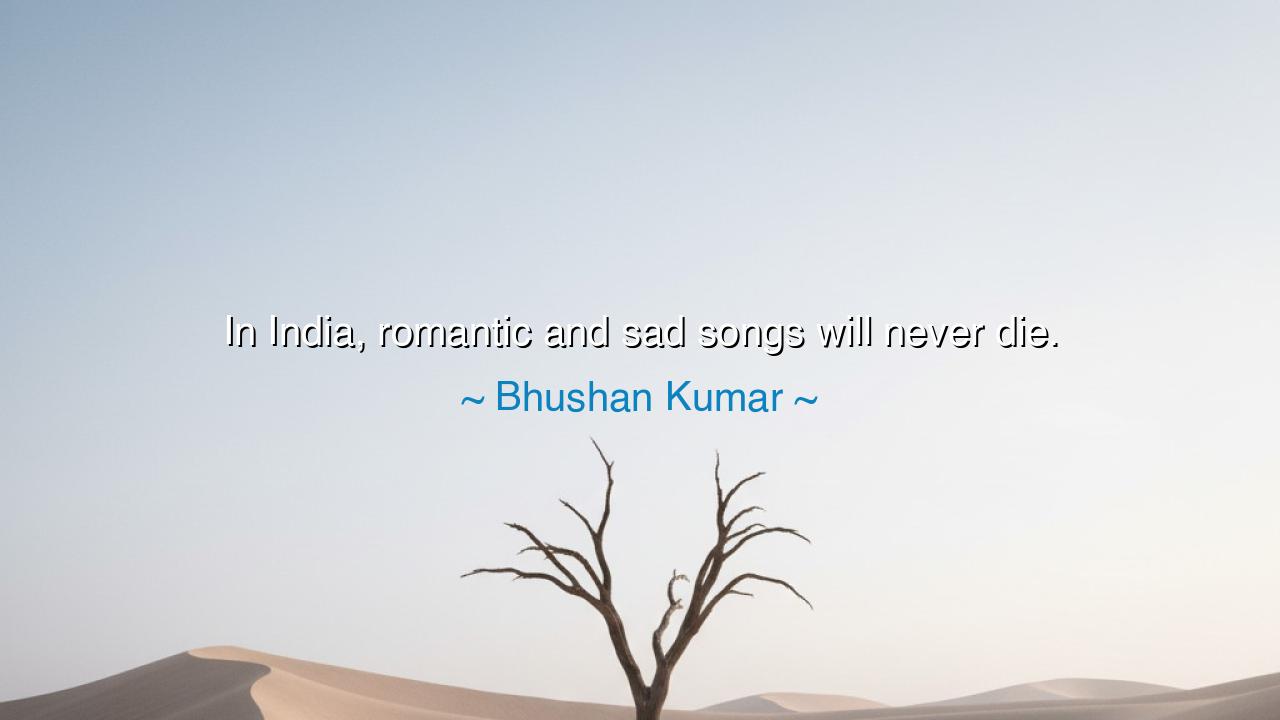
In India, romantic and sad songs will never die.






Hear now, O children of melody and memory, the words of Bhushan Kumar, heir to the great musical lineage of India’s cinema and heart: “In India, romantic and sad songs will never die.” In this single sentence lies a truth that transcends generations — a truth about the soul of a nation, about the emotional rhythm that beats within its people. For India, a land of contrasts — of joy and longing, of passion and pain — has always sung its story through music. And in this music, the eternal companions of love and sorrow find their immortal home.
The origin of this quote lies in Bhushan Kumar’s stewardship of T-Series, the vast empire of Indian music and film. As the son of Gulshan Kumar, who revolutionized devotional and cinematic music, Bhushan inherited not only a business but a tradition — a cultural truth that melodies of love and grief never lose their place. When he speaks of romantic and sad songs as eternal, he is not merely making a statement about popularity; he is recognizing something sacred about the Indian heart — that it feels deeply, and expresses that depth through song.
From the dawn of its civilization, India’s art has been shaped by bhava — the emotion that animates beauty. Ancient poets like Kalidasa wrote of love’s sweetness and sorrow with the same reverence as they wrote of gods and kings. In classical ragas, the very notes themselves were designed to evoke feeling: Raga Yaman for devotion, Raga Desh for longing, Raga Bhairavi for heartbreak. Even today, whether in a film ballad or a street singer’s tune, the same ancient pulse lives on. Love and sadness are not passing moods in India—they are eternal states of being.
Bhushan Kumar’s words also reflect the power of music to bind a people together across generations. Consider the songs of Lata Mangeshkar, whose voice carried both the ache of parting and the tenderness of first love. Her melodies, like those of Kishore Kumar or Mohammed Rafi, remain as alive today as they were half a century ago. They remind us that while fashion and technology change, the emotions that define humanity remain constant. The romantic and the sorrowful are not genres of entertainment; they are the sacred languages of empathy.
In saying “will never die,” Bhushan speaks to something beyond art — the immortality of emotion. For as long as humans love, they will sing of love. As long as they lose, they will sing of loss. Music becomes the bridge between what is fleeting and what endures. The heart’s pain is transformed into beauty; its joy, into gratitude. India, with its heritage of devotional poetry, ghazals, and cinematic music, understands this better than most — that to sing is to heal, and to remember is to live.
This truth finds echo in other times and lands. Beethoven, when struck by deafness, still composed symphonies that sang of triumph and tenderness. His art proved that even suffering can create light. Similarly, Indian musicians, from rural folk singers to modern playback artists, have turned heartbreak into harmony. They teach that sadness, when embraced, becomes wisdom; love, when sung, becomes eternal.
The lesson within Bhushan Kumar’s reflection is simple yet profound: cherish emotion. Do not numb it in the rush of modern life. Let music remind you of what it means to feel — to love, to yearn, to lose, to hope again. Whether through a film song or a folk melody, let the art of feeling remain alive in you. For a heart that can weep and sing is a heart that still breathes the fullness of life.
Thus, let the words of Bhushan Kumar echo across time: “In India, romantic and sad songs will never die.” Because in truth, it is not only India’s songs that live forever — it is the human heart itself, unbroken through centuries, still finding its voice in love and loss, still singing its story beneath the same eternal sky.






AAdministratorAdministrator
Welcome, honored guests. Please leave a comment, we will respond soon